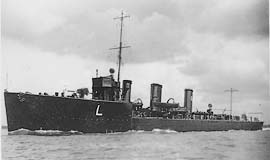Technical innovations
Leonidas, together with Lucifer, was one of two experimental destroyers ordered in 1912 from Parsons to be fitted with fully geared turbines. Gearing meant that the turbine itself could run at higher speeds than the propeller, which improved efficiency. Two previous experimental destroyers, Badger and Beaver had been ordered in 1911 which used gearing for the high pressure (HP) turbines but not for the low pressure (LP) ones. Sufficiently robust gearboxes were at that time experimental and were only just being produced by Parsons who had developed innovative gear cutting equipment. Ships propellers rotated at a maximum speed of 380 rpm, while the LP turbines ran at 1800 rpm and the HP at 3000 rpm. It was anticipated that the additional gearing would produce an overall 10% increase in efficiency, ranging from 9% at full power to 26% at low power, since turbines are more efficient at higher speeds and performance particularly suffered when the engines were running slowly. Comparative tests indicated the savings equated to the ships being able to remain on patrol at cruising speeds for an extra two days as compared to a ship using partially geared turbines. Cost of the ships increased because of providing gearboxes, but this was partly offset against a reduction in the total necessary power from the turbine to achieve a given speed, meaning that smaller and cheaper turbines could be used. Other ships of the class built without LP gearing required 24,500 shp compared to 22,500 shp for this design. [1]
Two designs were produced for the ships propellers because of disagreement between the admiralty and Parsons on the better design. For the same overall dimensions, Parsons used a blade area of 54 square feet (5.0 m2) while the admiralty preferred 42.5 sq ft (3.95 m2). The introduction of gearing meant that bearings holding the shafts were now subject to large lateral forces where the gears pushed against each other. This was a significant difficulty in gearbox design but was overcome by the introduction of the new Michell tilting-pad fluid bearing. This was first employed in 1913 on a cross-channel steamer, Paris built by Denny of Dunbarton which also used geared turbines, and then on Leonidas and Lucifer. Traditional bearings were found unable to support the forces in turbine gearboxes but also had higher friction in more traditional application with reciprocating engines. It was estimated that the reduced frictional losses on new bearings introduced throughout the fleet saved the admiralty £500,000 in reduced fuel consumption in 1918. [2] [3]

HMS Lydiard was a Laforey-class destroyer built for the Royal Navy during the 1910s.

The Laforey class was a class of 22 torpedo boat destroyers of the Royal Navy, twenty of which were built under the Naval Programme of 1912–13 and a further two under the 2nd War Emergency Programme of 1914. As such they were the penultimate pre-war British destroyer design. All served during World War I during which three were lost; the survivors were all scrapped in 1921-23.

HMS Calliope was a C-class light cruiser of the Royal Navy under construction at the outbreak of the First World War. Both Calliope and her sister ship Champion were based on the earlier cruiser Caroline. They were effectively test ships for the use of geared turbines which resulted in the one less funnel. They also received slightly thicker armour. They led into the first of the Cambrian subclass.
HMS Ossory was an Admiralty M-class destroyer built for the Royal Navy during the First World War. She took part in the Battle of Jutland in 1916 and was sold for scrap in 1921.
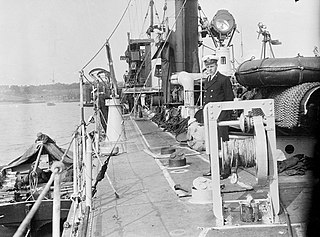
HMS Laforey was the lead ship of her class of destroyer built for the Royal Navy. Launched a year before the First World War began, she was attached to the Dover Patrol. Laforey saw action in several engagements with German torpedo boats, including the Battle off Noordhinder Bank and the action of 17 March 1917. Laforey was sunk in 1917 by a British mine after escorting several freighters to France. She was named for Francis Laforey, captain of HMS Spartiate at the Battle of Trafalgar in 1805.
HMS Nomad was an Admiralty M-class destroyer built for the Royal Navy during the First World War. She was sunk during the Battle of Jutland in 1916.

HMS Champion was a C-class light cruiser of the Royal Navy that saw service during World War I. She was part of the Calliope group of the C class.
HMS Phoebe was an Admiralty M-class destroyer built for the Royal Navy during the First World War. She took part in the Zeebrugge Raid in 1918 and was sold for scrap in 1921.
HMS Ophelia was an Admiralty M-class destroyer built for the Royal Navy during the First World War, entering service in 1916. The ship served at the Battle of Jutland on 31 May/1 June 1916, and sank a German submarine in 1918. She was sold for scrap in 1921.

HMS Legion was a Laforey-class destroyer built for the Royal Navy during the 1910s.
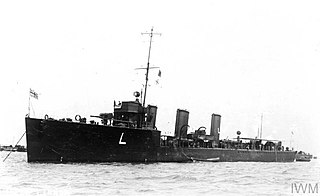
HMS Lennox was a Laforey-class destroyer built for the Royal Navy during the 1910s.
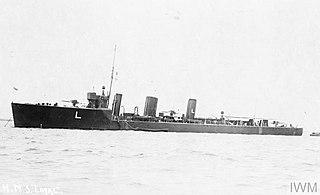
HMS Loyal was a Laforey-class destroyer built for the Royal Navy during the 1910s.
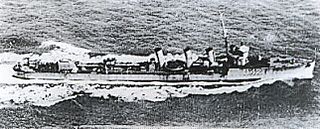
HMS Pasley was an Admiralty M-class destroyer built on the Tyne by Swan Hunter & Wigham Richardson for the Royal Navy and launched on 15 April 1916. She saw service during the First World War.
HMS Narborough was an Admiralty M-class destroyer built for the Royal Navy during the First World War. She was wrecked after running aground in 1918.

HMS Lynx was one of 20 Acasta-class destroyers built for the Royal Navy in the 1910s. Completed in 1914 she saw active service in the First World War.

HMS Strongbow was an M-class destroyer built for the British Royal Navy during the First World War. The ship was launched in September 1916 and entered service in November that year. Stongbow was sunk on 17 October 1917 by the German light cruisers SMS Bremse and Brummer in the North Sea, when escorting a convoy of merchant ships from Norway.

HMS Partridge was a Royal Navy Admiralty M-class destroyer constructed and then operational in the First World War, later being sunk by enemy action in 1917. The destroyer was the sixth Royal Navy vessel to carry the name HMS Partridge.
HMS Pheasant was one of 85 Admiralty M-class destroyers built during the First World War for the Royal Navy. She hit and was sunk by a mine in 1917.
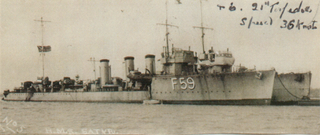
HMS Satyr was an R-class destroyer which served with the Royal Navy during the First World War. Launched on 27 December 1916, Satyr joined the Harwich Force under the command of Commander Hubert de Burgh. In 1917, the destroyer formed part of a force protecting the monitors Erebus and Terror in their bombardment of Ostend. As part of this action, Satyr, along with sister ships Taurus, Sharpshooter and Torrent, sank the German destroyer S20. After the war, the ship served with the Torpedo School at the Devonport. In 1923, the Navy decided to retire many of the older destroyers in preparation for the introduction of newer and larger vessels and Satyr was sold to be broken up on 16 December 1926.

HMS Urchin was a modified Admiralty R-class destroyer which served with the Royal Navy. It was the third ship in the Navy to be named after the sea urchin and the first in the class to be built by Palmers in Jarrow. It was launched in 1917 and served with the Grand Fleet during World War I, seeing action in the Second Battle of Heligoland Bight.
This page is based on this
Wikipedia article Text is available under the
CC BY-SA 4.0 license; additional terms may apply.
Images, videos and audio are available under their respective licenses.
